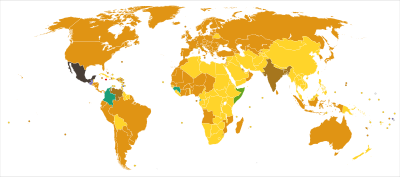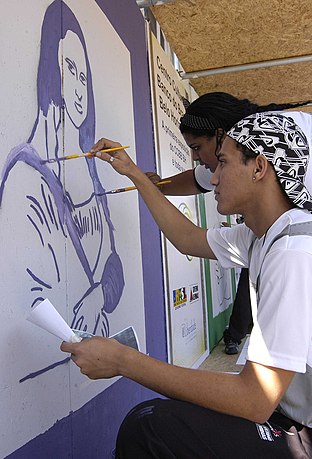Commons:Normes de drets d'autor
Els fitxers penjats a Commons haurien de ser gratuïts tant al país d'origen (tal com es defineix a la Convenció de Berna) com als Estats Units d'Amèrica, i possiblement a altres països implicats, ja sigui mitjançant la llicència adequada del propietari dels drets d'autor o bé en el domini públic
Normes sobre drets d'autor per subjecte
- Main page: Commons:Normes sobre drets d'autor per tema.
Commons:Normes sobre drets d'autor per tema reuneixen diversos temes i pretenen respondre a la pregunta "Puc penjar fotografies/imatges de ...?"
És correcte penjar:
- En general, les fotos que us heu fet de temes no subjectes a drets d'autor, com ara visualitzacions; naturalesa; tu mateix; i persones que han donat el seu consentiment perquè les fotografieu i publiqueu la fotografia. (Tot i això, recordeu que les càrregues han de ser educatives; Commons no és el vostre espai web privat.)
- Fotos fetes per vosaltres, o escanejades o fotocòpies fetes per vosaltres d'objectes o dissenys els drets d'autor dels quals han expirat (normalment 70 anys després de la mort de l'autor, però consulteu Normes sobre drets d'autor per territori per obtenir una llista país per país).
- Simples exploracions mecàniques o fotocòpies, fetes per algú altre, d'un objecte o disseny prou vell com per ser de domini públic (normalment 70 anys després de la mort de l'autor, però vegeu Normes sobre drets d'autor per territori per obtenir una llista país per país). Per a les exploracions d'imatges antigues que poden haver estat millorades, vegeu Commons:Quan utilitzar l'etiqueta PD-scan.
- Fotografies, fetes per vosaltres mateixos o per algú altre, que siguin reproduccions fidels d'obres d'art 2D de domini públic. Vegeu Commons:Quan utilitzar l'etiqueta PD-Art.
Es poden permetre o no altres temes; vegeu els encapçalaments de Commons:Normes sobre drets d'autor per tema. Si voleu respondre a la pregunta "Puc penjar fotografies/imatges de ...?", Consulteu la secció de Commons:Normes sobre drets d'autor per tema en les imatges d'Internet. Vegeu també: Commons:Llindar d'originalitat.
Llista de control
Suposem que feu una fotografia amb la vostra càmera, o que heu escanejat quelcom, o que ho heu baixat d'una pàgina web, i que voleu pujar-ho a Wikimedia Commons. Com saber què és correcte i què no? A continuació teniu una llista senzilla per a ajudar-vos a decidir-ho. En cas de dubte, llegiu primer els consells addicionals aplicables al vostre país. Si llavors seguiu sense estar segur, pregunteu en el Commons:Help desk o en Commons:Village pump en el vostre idioma.
Vegeu Commons:Normes sobre drets d'autor per tema per a una llista més completa.
 Correcte
Correcte
Fotografies pròpies de:
- Naturalesa (boscs, cel, etcètera).
- Animals (gats, gossos, etcètera).
- Insectes (formigues, escarabats, etcètera).
- Productes (pomes, tomàquets, etcètera)
- Persones que han donat el seu consentiment per a ser fotografiades.
- Vosaltres mateixos (sempre que no ho useu com a àlbum digital privat), però no imatges que t’han fet altres persones (requereixen el consentiment de qui ha fet la foto)
- Objectes que estan en el domini públic per antiguitat tant als Estats Units com en la vostra jurisdicció:
- Edificis construïts per un arquitecte que va morir fa més de 70 anys (preferiblement més de 100).
- Obres d'art creades per un artista que va morir fa més de 70 anys (preferiblement més de 100) i que fou publicat per primer cop abans de 1928
- Llibres d'un escriptor que va morir fa més de 70 anys (preferiblement més de 100) i que fou publicat per primer cop abans de 1928
- Diaris i revistes publicades per un autor que va morir fa més de 70 anys (preferiblement més de 100) i que fou publicat per primer cop abans de 1928
Escanejats propis de:
- Material els drets d'autor del qual han expirat en la vostra jurisdicció i als Estats Units.
- Fotos creades completament per vosaltres (que no estiguin basades en una font anterior o que aquesta font sigui de domini públic)
Baixat de llocs web:
- Material els drets d'autor del qual han expirat en la vostra jurisdicció, als Estats Units i a la jurisdicció del servidor web.
Discutible, pot ser correcte o no
Tot tipus de material amb drets d'autor:
- Logotips (només es permeten dissenys molt simples, vegeu la secció de dissenys simples).
- Captures de pantalla (vegeu Commons:Captures de pantalla.)
Fotografies, dibuixos, escanejats i altres reproduccions de:
- Automòbils. (es permeten els cotxes amb un sol color i sense anuncis, pintures, etc.)
- Productes d'ús diari (es permeten els dissenys simples).
- Portades de llibres (només es permeten dissenys molt simples).
- Diners (depèn de les lleis locals, vegeu Commons:Diners)
- Segells (depèn de la legislació del país; consulteu Commons:Segells)
- Edificis construïts per un arquitecte que va morir fa menys de 70 anys, o encara és viu (vegeu Commons:Llibertat de panorama).
- Obres d'art instal·lades permanentment en llocs públics, creades per un artista que va morir fa menys de 70 anys, o encara és viu. Vegeu Llibertat de panorama.
- Interiors d'edificis privats, cases i museus.
- Personatges famosos. Vegeu Commons:Fotografies de persones identificables.
- Persones normals que no hagin donat el seu consentiment. Vegeu Commons:Fotografies de persones identificables.
 No permès
No permès
- Imatges d'"ús raonable" (fair use). Vegeu Commons:Ús raonable.
- Fan art que imite detingudament material amb drets d'autor. Vegeu Commons:Fan art.
- Fotografies, dibuixos, escanejats i altres reproduccions d'objectes amb drets d'autor que no us pertanyen, com els següents:
- Ninotets, estatuetes, disfresses i altres objectes subjectes a drets d'autor. Vegeu Commons:Obres derivades.
- Àlbums de música, jocs de vídeo, pel·lícules i altres cobertes de productes comercials, pòsters, diaris i revistes els drets d'autor dels quals no han caducat (cobertes i interiors).
- Registres d'àudio amb drets d'autor que no us pertanyen, com els següents:
- Emissions de ràdio (programes i publicitat).
- Cançons creades per un autor els drets d'autor dels quals no han expirat
Normes de drets d'autor per territori
- Main page: Normes sobre drets d'autor per territori.

Laws about copyright differ from country to country. Images uploaded to Commons, unless uploaded from the United States, involve the interaction of two or more copyright jurisdictions. The laws of individual countries differ especially in the following points:
- The time for which a copyright applies. In most countries, copyright expires no later than 70 years after the death of the author (p.m.a.). There may be special terms for recently published old material.
- Status of works of the government. In many (but not all) countries, documents published by the government for official use are in the public domain.
- Material applicable for copyright. In some jurisdictions, pictures of artistic work like architecture, sculptures, clothing etc. can not be used freely without the consent of the creator of the original artwork.
Almost all countries in the world are party to the Berne Convention for the Protection of Literary and Artistic Works (see here for the text). Following this convention, countries enforce copyrights from other countries, according to certain rules. One consequence of these rules is that we should always care about the laws of the country of origin of the work.
Tractar la incertesa
Quan es desconeix la data

Assume the most recent possible date considering the subject. The photo here shows Albert Einstein and his wife Elsa. Elsa died on December 20, 1936; Albert later on April 18, 1955. Therefore, it was taken before December 20, 1936.
Quan es desconeix el lloc
Assume the most restrictive reasonably possible location considering the subject. In the Einstein photo here, it could be the United States, Germany, the Atlantic Ocean (assuming the Einstein couple was on board a ship) or any other country or location he reasonably could have gotten a photo taken in, but it would not likely be Nepal, for example.
Quan es desconeix el fotògraf
Assume the most reasonable restrictive copyright barring evidence to the contrary. That is, unless the site or source itself asserts a freer set of rights (and you have good reason to believe they are not misapplying rights they do not have) assume the photographer retained all rights he legally could in his jurisdiction.
But the Berne Convention says that photographs are in the public domain 50 years after publication if the photographer is unknown. This applies unless a country has made a specific law.
Generally, for countries with copyright terms based on the death of the author, community consensus has found that it is safe to assume that the author died no more than 50 years after creating the work in cases where the author is unknown. This is encapsulated in the template {{PD-old-assumed}}.
Exemple

Assume that the author of the image on the right is unknown to us, but not unknown in the copyright sense. We know that the image represents the ship Borda, which was scrapped in 1891. The image could have been taken that year by a 20-year-old man, who could die of old age in his 90s; this brings us to 1960. Assuming the normal terms for "works" apply and a 70-year long copyright term pma, the image would be covered by copyright until the 2030s. If the work was truly anonymous, then the copyright probably did not exceed 1891 + 70 = 1961, which means it is free if it was published before 1928 (or free in USA for other reasons).
Caution, not being able to find an author does not mean that the work is anonymous. It can mean that we did not search long enough or at the right place.
Vegeu també: Commons:Abast del projecte/Principi preventiu.
Vegeu també
- Commons:Wikilivres – a similar site which is not operated by the Wikimedia Foundation but which allows for material in the Canadian public domain which is less restrictive than the United States
- Look at the Frequently Asked Questions.
- If you place
{{helpme}}on your talk page, a volunteer will visit you there as soon as possible! - Join the #wikimedia-commons IRC channel for real-time chat. New to IRC? Click here to be connected instantly!
- Go to the Commons Help Desk.


